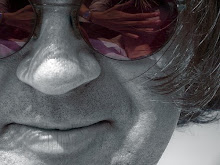
Yesterday I went to see the Bodyworks exhibition at the O2 in Greenwich, London. It was fascinating and I heartily recommend it to anyone interested in the mechanics of the human body. What was especially fascinating to me as an artist was the display about sight. The artist Monet had very bad eyesight in later life. Later, his vision was so bad that he could barely discern shapes. What became to be called Impressionism (at least as far as Monet was concerned) was literally an impression of what he saw. What really fascinated me was that, not only was his inability to see the subject he was painting, but also his inability to see the resultant painting. It was like a double whammy. The final painting had little chance of looking like the subject. But it did. So how did he do it? When I was at school, painting, my teacher told me to paint what I saw and not what I knew to be there. For example, you don't paint every leaf on a tree. Instead you give the impression of a lot of leaves. I think that Monet was using his memory of what he knew to be there but, more importantly, as some compensation for his poor eyesight, he had developed another sense of what was around him which enabled him to paint. wouldn't it be nice if we all could develop senses to truly appreciate the world around us in our busy day-to-day lives? I don't think we should take any of our senses for-granted......
Incidentally, Monet had a cataract operation a couple of years before he died. I wonder what he thought of his paintings when he saw them with restored eyesight?
Above is a photo taken on Plumstead Common, SE London. The fog reminded me of the story above.

The fog makes this photos mysterious, I love the trees.
ReplyDeleteWhat a great photo, infact all the photos on your blog a wonderful and thought provoking!
ReplyDeletebeautiful shot!!! taht atmosphere!
ReplyDeleteciao, Luis
this is a beautiful photo.
ReplyDeleteOooh, gorgeous. I love fog, especially when it blends in with the trees.
ReplyDelete